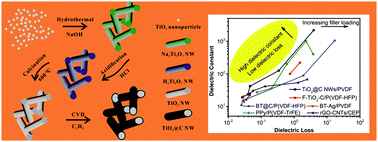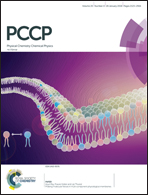Largely enhanced dielectric constant of PVDF nanocomposites through a core–shell strategy†
Abstract
Core–shell structured TiO2@carbon nanowire (TiO2@C NW) hybrids with different carbon shell thicknesses were synthesized by a combination of a hydrothermal reaction and the chemical vapor deposition (CVD) method. Pristine TiO2 NWs with a high aspect ratio were obtained by a hydrothermal reaction and the as-synthesized TiO2 NWs were subsequently employed as the template for carbon shell deposition during the CVD procedure. The obtained TiO2@C NW hybrids have a uniform carbon shell and the thickness of the carbon shell could be precisely designed from 4 nm to 40 nm by controlling the deposition time. With the help of solution and melt blending methods, the TiO2@C NW hybrids were subsequently incorporated into the PVDF matrix to fabricate TiO2@C NWs/PVDF nanocomposites, which exhibit a similar percolative dielectric behavior to that reported in other percolative nanocomposites. Moreover, the dielectric properties of the TiO2@C NWs/PVDF nanocomposites could be accurately adjusted by tuning the carbon shell thickness of the TiO2@C NW hybrids. The highest dielectric constant (2171) of the TiO2@C NWs/PVDF nanocomposites is 80 times larger than those of the pristine TiO2-filled ones at the same filler loading, and 241 times higher than that of the pure PVDF matrix. The enhanced dielectric performance could be attributed to the improved interfacial polarizations of TiO2/C and C/PVDF interfaces. This approach provides an interesting alternative to fabricate high-performance dielectric nanocomposites for practical applications in the electronic industry.

- This article is part of the themed collection: 2018 PCCP HOT Articles


 Please wait while we load your content...
Please wait while we load your content...